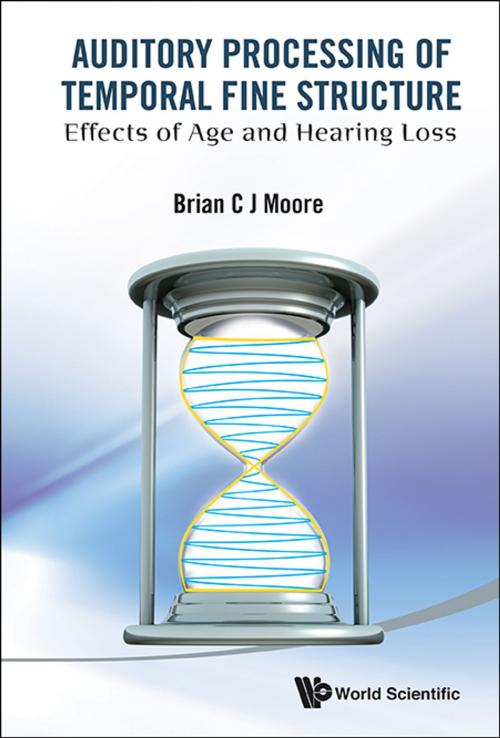Auditory Processing of Temporal Fine Structure
Effects of Age and Hearing Loss
Nonfiction, Health & Well Being, Medical, Specialties, Otorhinolaryngology, Internal Medicine, Neurology| Author: | Brian C J Moore | ISBN: | 9789814579674 |
| Publisher: | World Scientific Publishing Company | Publication: | February 28, 2014 |
| Imprint: | WSPC | Language: | English |
| Author: | Brian C J Moore |
| ISBN: | 9789814579674 |
| Publisher: | World Scientific Publishing Company |
| Publication: | February 28, 2014 |
| Imprint: | WSPC |
| Language: | English |
The book is concerned with changes in the perception of sound that are associated with hearing loss and aging. Hearing loss affects about 7% of the population in developed countries, and the proportion is increasing as the average age of the population increases. The audiogram is the most widely used diagnostic tool in audiology clinics around the world. The audiogram involves measuring the threshold for detecting sounds of different frequencies. Sometimes the audiogram is the only diagnostic tool that is used. However, hearing problems are not completely characterized by the audiogram. Two individuals with similar audiograms may show very different abilities in the detection and discrimination of sounds at above-threshold levels. Also, a person may have hearing difficulties despite having an audiogram that is within the range conventionally considered as ‘normal’. One factor that may influence the discrimination of sounds, especially the ability to understand speech in background sounds, is sensitivity to temporal fine structure (TFS).
This monograph reviews the role played by TFS in masking, pitch perception, speech perception, and spatial hearing, and concludes that cues derived from TFS play an important role in all of these. Evidence is reviewed suggesting that cochlear hearing loss reduces the ability to use TFS cues. Also, the ability to use TFS declines with increasing age even when the audiogram remains normal. This provides a new dimension to the changes in hearing associated with aging, a topic that is currently of great interest in view of the increasing proportion of older people in the population.
The study of the role of TFS in auditory processing has been a hot topic in recent years. While there have been many research papers on this topic in specialized journals, there has been no overall review that pulls together the different research findings and presents and interprets them within a coherent framework. This monograph fills this gap.
Contents:
- Processing of Sound in the Auditory System and Neural Representation of Temporal Fine Structure
- The Role of TFS in Masking
- The Role of TFS in Pitch Perception
- The Role of TFS in Speech Perception
- The Influence of Hearing Loss and Age on the Binaural Processing of TFS
- Overview, Conclusions and Practical Implications
Readership: Medical professionals, academics and clinicians in hearing, life science students and biomedical researchers.
Key Features:
- Sensitivity to temporal fine structure (TFS) in sound is currently a hot topic, but no other book focuses on this topic
- The book provides a critical review and interpretation of data on sensitivity to TFS and how sensitivity is affected by hearing loss and age
- The author has published extensively in this area
The book is concerned with changes in the perception of sound that are associated with hearing loss and aging. Hearing loss affects about 7% of the population in developed countries, and the proportion is increasing as the average age of the population increases. The audiogram is the most widely used diagnostic tool in audiology clinics around the world. The audiogram involves measuring the threshold for detecting sounds of different frequencies. Sometimes the audiogram is the only diagnostic tool that is used. However, hearing problems are not completely characterized by the audiogram. Two individuals with similar audiograms may show very different abilities in the detection and discrimination of sounds at above-threshold levels. Also, a person may have hearing difficulties despite having an audiogram that is within the range conventionally considered as ‘normal’. One factor that may influence the discrimination of sounds, especially the ability to understand speech in background sounds, is sensitivity to temporal fine structure (TFS).
This monograph reviews the role played by TFS in masking, pitch perception, speech perception, and spatial hearing, and concludes that cues derived from TFS play an important role in all of these. Evidence is reviewed suggesting that cochlear hearing loss reduces the ability to use TFS cues. Also, the ability to use TFS declines with increasing age even when the audiogram remains normal. This provides a new dimension to the changes in hearing associated with aging, a topic that is currently of great interest in view of the increasing proportion of older people in the population.
The study of the role of TFS in auditory processing has been a hot topic in recent years. While there have been many research papers on this topic in specialized journals, there has been no overall review that pulls together the different research findings and presents and interprets them within a coherent framework. This monograph fills this gap.
Contents:
- Processing of Sound in the Auditory System and Neural Representation of Temporal Fine Structure
- The Role of TFS in Masking
- The Role of TFS in Pitch Perception
- The Role of TFS in Speech Perception
- The Influence of Hearing Loss and Age on the Binaural Processing of TFS
- Overview, Conclusions and Practical Implications
Readership: Medical professionals, academics and clinicians in hearing, life science students and biomedical researchers.
Key Features:
- Sensitivity to temporal fine structure (TFS) in sound is currently a hot topic, but no other book focuses on this topic
- The book provides a critical review and interpretation of data on sensitivity to TFS and how sensitivity is affected by hearing loss and age
- The author has published extensively in this area















